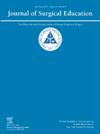Impact of a Pediatric Ambulatory Surgical Center on Surgery Resident Education
IF 2.6
3区 医学
Q1 EDUCATION, SCIENTIFIC DISCIPLINES
引用次数: 0
Abstract
Objective
Most operative education for surgery trainees occurs in primary academic hospitals. The impact of ambulatory surgery centers (ASCs) on resident operative experience with adult procedures is variable but has not been reported regarding pediatric cases. We hypothesized that the introduction of a pediatric ASC in our health system led to decreased opportunities for surgery residents to participate in ACGME-required cases.
Design
We performed a retrospective analysis of operative data from the electronic health record (EHR) and resident-reported case logs for procedures performed at an academic children's hospital (CH) and its pediatric ASC from 2018 to 2023. Pediatric surgery first performed operations at the ASC in May 2020. Operative cases analyzed were those performed at both the ASC and the CH. The presence of trainees in overlapping case types was analyzed, and descriptive statistics were performed.
Setting
Vanderbilt University Medical Center, General Surgery training program and Vanderbilt Children's Hospital, both quaternary care centers.
Participants
General surgery residents rotating on the Pediatric Surgery service between 2018 and 2023.
Results
Overlapping cases included inguinal, umbilical, and epigastric herniorrhaphies, as well as subcutaneous lesion excisions. Of 17,012 cases performed by pediatric surgeons during the study period, 5,413 (31.8%) were overlapping cases, and 599 (3.5%) were performed at the ASC. Retrospective review of the EHR demonstrated resident presence in 82.9% of CH cases before the ASC and 81.8% afterwards. Resident presence in ASC cases was minimal (n = 9). Categorical General Surgery and Pediatric Surgery residents had no decrease in case volume after ASC initiation based on EHR data or case logs.
Conclusions
The introduction of a pediatric ASC did not reduce resident operative experience but represents a missed educational opportunity in the ambulatory setting.
求助全文
约1分钟内获得全文
求助全文
来源期刊

Journal of Surgical Education
EDUCATION, SCIENTIFIC DISCIPLINES-SURGERY
CiteScore
5.60
自引率
10.30%
发文量
261
审稿时长
48 days
期刊介绍:
The Journal of Surgical Education (JSE) is dedicated to advancing the field of surgical education through original research. The journal publishes research articles in all surgical disciplines on topics relative to the education of surgical students, residents, and fellows, as well as practicing surgeons. Our readers look to JSE for timely, innovative research findings from the international surgical education community. As the official journal of the Association of Program Directors in Surgery (APDS), JSE publishes the proceedings of the annual APDS meeting held during Surgery Education Week.
 求助内容:
求助内容: 应助结果提醒方式:
应助结果提醒方式:


